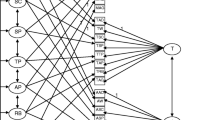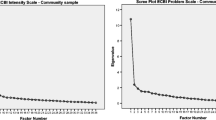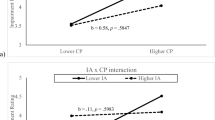Abstract
The purpose of this study was to determine whether profile patterns derived from parents' ratings of clinically referred boys were significantly associated with differences in functioning identified via teachers' ratings, direct observations, cognitive tests, and personality measures. Subjects were 185 6- to 11-year-old boys who were referred to an outpatient psychiatric service or school psychologist and whose Child Behavior Checklist (CBCL) profiles correlated significantly with types previously identified through cluster analysis. Comparisons of boys classified by six CBCL profile types and Internalizing versus Externalizing groupings of these types showed many differences that are not apt to be evident in linear correlations between the different sources of data. The findings provide a basis for research on differences between profile patterns with respect to etiology, course, prognosis, and responsiveness to interventions. They also indicate the potential importance of higher-order patterns of functioning that extend across multiple sources of data.
Similar content being viewed by others
References
Achenbach, T. M. (1985).Assessment and taxonomy of child and adolescent psychopathology. Newbury Park, CA: Sage.
Achenbach, T. M. (1986).The Direct Observation Form of the Child Behavior Checklist (rev. ed.). Burlington: University of Vermont.
Achenbach, T. M., & Edelbrock, C. (1978). The classification of child psychopathology: A review and analysis of empirical efforts.Psychological Bulletin, 85, 1275–1301.
Achenbach, T. M., & Edelbrock, C. (1983).Manual for the Child Behavior Checklist and Revised Child Behavior Profile. Burlington: University of Vermont.
Achenbach, T. M., & Edelbrock, C. (1986).Manual for the Teacher's Report Form and Teacher Version of the Child Behavior Profile. Burlington: University of Vermont.
Achenbach, T. M., & McConaughy, S. H. (1987).Empirically-based assessment of child and adolescent psychopathology: Practical applications. Newbury Park, CA: Sage.
Achenbach, T. M., McConaughy, S. H., & Howell, C. T. (1987). Child/adolescent behavioral and emotional problems: Implications of cross-informant correlations for situational specificity.Psychological Bulletin, 101, 213–232.
Achenbach, T. M., & Zigler, E. (1963). Social competence and self-image disparity in psychiatric and nonpsychiatric patients.Journal of Abnormal and Social Psychology, 67, 197–205.
American Psychiatric Association. (1987).Diagnostic and statistical manual of mental disorders (3rd ed., rev.). Washington, DC: Author.
Cairns, E., & Cammock, T. (1978). Development of a more reliable version of the Matching Familiar Figures Test.Developmental Psychology, 14, 555–560.
Dunn, L. C., & Markwardt, F. C. (1970).Peabody Individual Achievement Test. Circle Pines, MN: American Guidance Service.
Edelbrock, C., & Achenbach, T. M. (1980). A typology of Child Behavior Profile patterns: Distribution and correlates for disturbed children aged 6–16.Journal of Abnormal Child Psychology, 8, 441–470.
Hollingshead, A. B. (1975).Four factor index of social status. New Haven, CT: Yale University Department of Sociology.
Kagan, J. (1966). Reflection-impulsivity: The generality and dynamics of conceptual tempo.Journal of Abnormal Psychology, 71, 17–24.
Katz, P. A., & Zigler, E. (1967). Self-image disparity: A developmental approach.Journal of Personality and Social Psychology, 5, 186–195.
Katz, P. A., Zigler, E., & Zalk, S. R. (1975). Children's self-image disparity: The effects of age, maladjustment, and action-thought orientation.Developmental Psychology, 11, 546–550.
Reed, M., & Edelbrock, C. (1983). Reliability and validity of the Direct Observation Form of the Child Behavior Checklist.Journal of Abnormal Child Psychology, 11, 521–530.
Rothbaum, F., Wolfer, J., & Visintainer, M. (1979). Coping behavior and locus of control in children.Journal of Personality, 47, 118–135.
Wechsler, D. (1974).Manual for the Wechsler Intelligence Scale for Children-Revised. New York: Psychological Corporation.
Winer, B. J. (1971).Statistical principles in experimental design (2nd ed.). New York: McGraw-Hill.
World Health Organization. (1978).Mental disorders: Glossary and guide to their classification in accordance with the ninth revision of the International Classification of Diseases. Geneva: Author.
Author information
Authors and Affiliations
Additional information
This research was supported by grants from the Spencer Foundation, the W. T. Grant Foundation, and NIMH Grant 40305. The authors are grateful to Heather McCollum and Nancy Pandina for serving as observers, and to the parents, children, teachers, and principals who made this study possible.
Rights and permissions
About this article
Cite this article
McConaughy, S.H., Achenbach, T.M. & Gent, C.L. Multiaxial empirically based assessment: Parent, teacher, observational, cognitive, and personality correlates of Child Behavior profile types for 6- to 11-year-old boys. J Abnorm Child Psychol 16, 485–509 (1988). https://doi.org/10.1007/BF00914262
Revised:
Issue Date:
DOI: https://doi.org/10.1007/BF00914262




